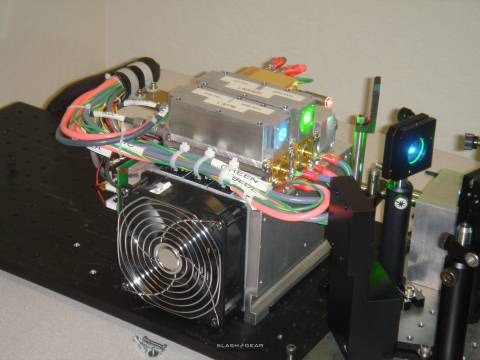SlashGear Exclusive: Video Demo Of Coherent Laser TV Tech
In an exclusive video interview with Coherent, the goggle-eyed boffins behind the laser TV gave SlashGear a brief run-down of just why the future of big-screen entertainment might leave lamps behind. With a spread of visible colour roughly double that of traditional lamp-based backlighting, using their a high-powered solid-state laser array of green, blue and red means they can fit far greater performance into a form-factor equal to or smaller than a standard mercury arc lamp. Watch the videos and then read on to find out more...
[flv]https://www.slashgear.com/videos/slashgear_lasertv.flv[/flv]SlashGear Exclusive Laser TV video 1
As screens get bigger and consumers wiser to the all-important trio of colour, contrast and lifespan, many different technologies are holding their hands up and squealing "me! me!" in an attempt to get noticed. If there's one thing that's certain, it's that CRT – long the mainstay of the average home – is steadily dropping in popularity as micro-display panel based screens grow in favour.
And just what the Simon & Garfunkel are "micro-display panels", I hear you grumble; well, they're the panels inside a front or rear-projection system that organise whether the red, green or blue light gets through. Systems such as LCD, DLP, Liquid Crystal On Silicon (LCOS) and Sony's new GLV are all examples of micro-display panels; light that has been split into the three core colours is projected through them and onto the screen.
[flv]https://www.slashgear.com/videos/slashgear_lasertv2.flv[/flv]SlashGear Exclusive Laser TV video 2
So where do lasers come in? Well, up until now the primary light source that provides those three core RGB colours has been either a metal-halide or xenon arc lamp; that's mainly because of the relative bulk and expense of commercially-available blue lasers pricing the technology out of the market. Coherent, however, have developed a so-called Optically Pumped Semiconductor (OPS) laser which can be readily tuned to the green and blue wavelengths necessary, in an affordable and relatively compact format that relies on very few parts.
Keep reading about these advanced laser backlighting systems on page 2...

You want to know if it's any good, though, don't you. Well the potential is certainly there for a jump in big-screen performance: laser light-sources can produce 85% of the colours that your eyes can see (compared to around 40% produced by current bulb technology), with purer whites and greater colour saturation. Contrast ratios are also improved, with typical numbers of 2000:1 for laser comparing very favourably to the 250:1 of LCD-based rear-projection TVs. If it's your wallet you're thinking of, you might be surprised to hear that the same bulb that lasts 8,000 hours on a 40-inch screen will only manage 2,000 when tasked with a 60-inch screen; compare that to 10,000-20,000 hours for a laser-based system.
Still got doubts? I can't really blame you, we've been promised so many "next big thing" breakthroughs that it's easy to get cynical. But Coherent have just signed a licencing agreement with OSRAM GmbH, one of the two leading light production manufacturers in the world, to develop OPS laser backlighting for consumer applications. Interestingly, while most of the headlines are fixated on bigger and brighter screens, OSRAM are also investigating OPS lasers being used in "pocket projectors" for hand-held devices.

It's exciting times for display technology; hopefully these two exclusive videos give you a better insight into where it might be going. Make sure you stay tuned to SlashGear for more exclusive content on laser TV technology!
